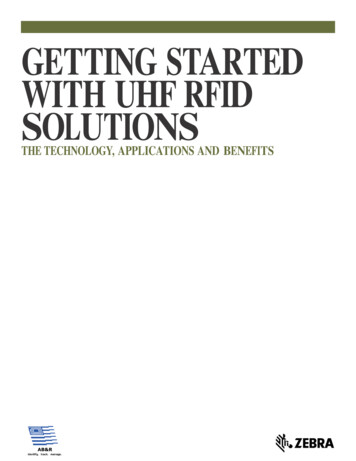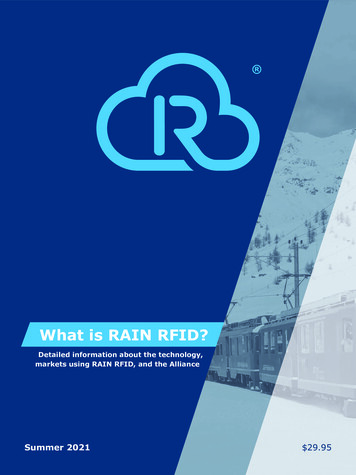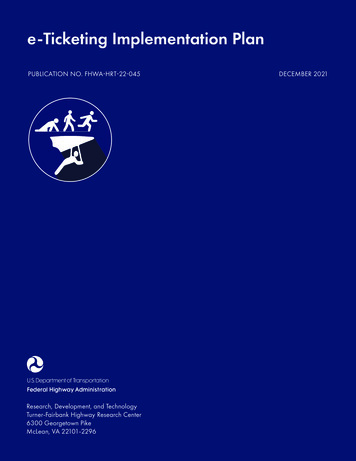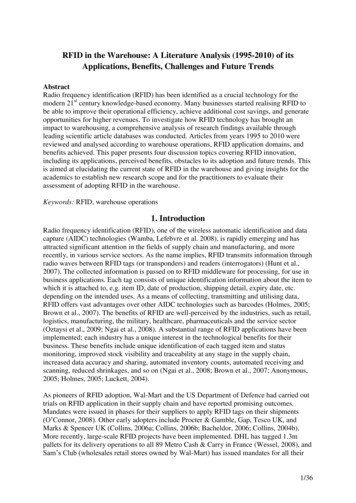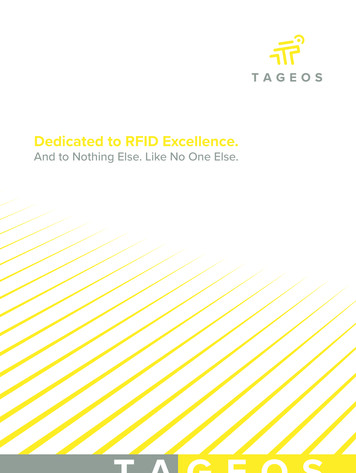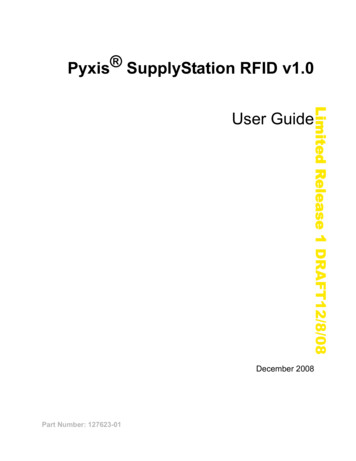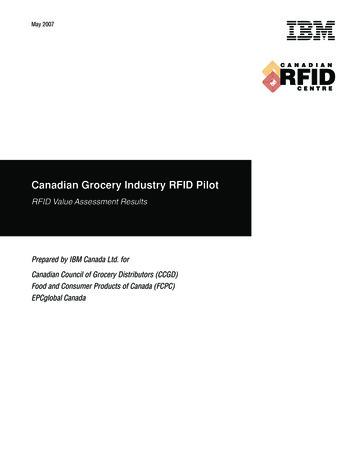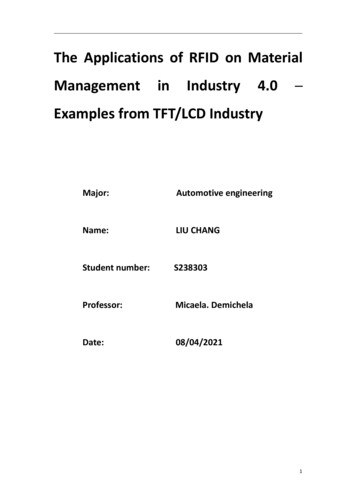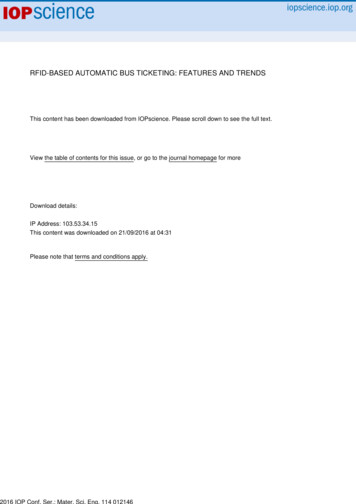
Transcription
HomeSearchCollectionsJournalsAboutContact usMy IOPscienceRFID-BASED AUTOMATIC BUS TICKETING: FEATURES AND TRENDSThis content has been downloaded from IOPscience. Please scroll down to see the full text.2016 IOP Conf. Ser.: Mater. Sci. Eng. 114 12146)View the table of contents for this issue, or go to the journal homepage for moreDownload details:IP Address: 103.53.34.15This content was downloaded on 21/09/2016 at 04:31Please note that terms and conditions apply.
iMEC-APCOMS 2015IOP PublishingIOP Conf. Series: Materials Science and Engineering 114 (2016) 012146 doi:10.1088/1757-899X/114/1/012146RFID-BASED AUTOMATIC BUS TICKETING:FEATURES AND TRENDSA. Oudah1Faculty of Manufacturing Engineering,Universiti Malaysia Pahang, MalaysiaE-mail: multicore.processor@yahoo.comAbstract. Recent advancements in various technologies have made remarkable developmentsin various fields for public welfare and public transport is one such area. In the near futurepublic bus transport system with advanced technologies like Radio Frequency IdentificationDevice (RFID), GSM, GPS, ZigBee and RF modules will gain spotlight due to their advantageof higher convenience and greater life standards as compared to the conventional bus systems.In this paper, a comprehensive review of all several proposed bus ticketing and bus informationmethods has been presented in detail. The study brings out improved solution in terms of cost,convenience, user satisfaction and future implementation. The choice of working modules andtheir efficient performance has been discussed along with the highlighted importance of theneed of technology for welfare of common public and visually impaired.1. IntroductionThere are around 6.7 billion people in this world, out of which 161 million are visually impaired.There are various challenges faced by visually impaired based on their specific level of vision [1]. Formost of the blind and visually impaired persons, the only viable mobility option to seek education,work and social connectivity is public transport [2]. However, they face many complex problems andchallenges to navigate especially while walking in the street and catching a bus. Hence, in order toease the accessibility of transportation for the visually impaired, various solutions are proposed [3].Also, in traditional ticketing system, each & everyday lots of tickets which are usually paper basedwhich consists of the date and the destination are being printed and sealed. The throwing of tickets bythe passengers pollutes the environment and causes a loss of trees from which paper is made.Therefore, a solution is provided by using automatic ticket systems. It enables operators to avoidmalpractices such as transferring tickets from one passenger to another and sharing of tickets, whichavoids confrontation or mesh between the supervisors and passengers and helps in safer handling ofdata. It also saves the transportation operators with time and personal costs [4].2. BackgroundAuthors of the project titled “Voice operated guidance systems for vision impaired people:investigating a user-centred open source model” developed a talking GPS system using a user centredclient server approach for easy navigation [1]. It uses a speech-recognition speech-synthesis interface.1To whom any correspondence should be addressed.Content from this work may be used under the terms of the Creative Commons Attribution 3.0 licence. Any further distributionof this work must maintain attribution to the author(s) and the title of the work, journal citation and DOI.Published under licence by IOP Publishing Ltd1
iMEC-APCOMS 2015IOP PublishingIOP Conf. Series: Materials Science and Engineering 114 (2016) 012146 doi:10.1088/1757-899X/114/1/012146The prototype solution includes a custom web application which accesses the Google maps API. Onthe other hand, the information in [3] suggests a technology ATVMS (Automatic Ticket Vending viaMessaging Service) which uses SMS (Short Messaging Service) or GSM as a medium to issue ticketswhich is financially and spatially viable. [3]The race of development continued in the project “RFID navigation system for the visually impaired”designed an embedded RFID reader at the bottom of the walking stick which comes in contact with anumber of tags on the ground. The user can enter the destination through voice recognition system andhe is guided by the voice output. The menu which can be picked by pressing buttons on the stick givesthe user the options such as to hear more information on their current location, identify nearbylocations, and receive directions from their current location to the next [4].Authors in [5] proposed Ticket friend mechanism employed in automatic ticket vending machineconsists of smart card RFID reader, PIC microcontroller, ZigBee, GSM which is utilized in bus stand.Ticket friendly machine holds the user account identity. As the smart card is inserted the RFID cardreads the user account and the destination entered by the user. ZigBee transmits the data related totransport arrival at that instant of inserting smart cards is transferred and displayed. [5]Others in [6] proposed two units, a bus unit and a handheld unit for the blind. Bus unit is used to findthe availability of blind in the bus station and displays it to the bus driver in the screen that consists ofa ZigBee transceiver with a microcontroller. The blind unit consists of a speech recognition system,which identifies the destination provided as a voice input by the blind person and also gives a voiceoutput of the corresponding bus number using ZigBee. [6]Furthermore, the findings in [7] suggested a glove worn in hand of visually impaired which has anRFID reader and a voice output which indicates the presence of an object around.This followed by the recommendations in [8] of a system with RFID card which automaticallycalculates the travel expense by sensing the source and destination locations through GPS. It alsomonitors the number of passengers entering the transport and also checks if it is equal to the number ofpassengers and the person can be fined. Authors in [9] developed a system that includes a mobileRFID reader, ZigBee transceiver for transmitting the tag’s information and Text to speech converterfor obtaining information through voice to the user and on the server side ZigBee transceiver. RFIDpassive tag network are employed on the path.Findings in [10] offer a system in which the transmitter transmits the information regarding the detailsof the bus when the smart card is entered. The transmitter detail received by the receiver helps it todistinguish between different buses. Voice announcement system is used to give the output regardingthe details.In addition, authors in [11] established a system which consists of RFID reader integrated with theZigBee technology, which provides all information regarding the booking such as the seat numberallotted, the cost etc. to both the operator as well as the passenger through GSM.Researchers in [12] used GPS system and smart cards to make travelling smarter. Smart card holds thedata of the passenger and GPS gives the location that helps in distance calculation. When thepassenger enters and leaves the bus the smart card can be used and the money that has been paid inadvance will be deducted from the card based on the distance travelled.Authors in [13] sheds light on a system which will help blind people to catch buses easily usingvibrating device, alarm and a tactile interface through a wireless communication system between the2
iMEC-APCOMS 2015IOP PublishingIOP Conf. Series: Materials Science and Engineering 114 (2016) 012146 doi:10.1088/1757-899X/114/1/012146transmitter and the receiver. VIPs will also get information about bus arrival and departure time. Thissystem also assists the bus operator to know the presence of a VIP on the road.Article [14] proposed a system consisting of an RFID tag in the front door to indicate arrival and at therear door to indicate departure. The passenger can enter information of their departure and destinationlocations through a keypad which is connected to a reader contained in each bus that is connected to amain server. According to the route distance between departure & destination, it calculates the ticketfare and deducts the credit from the RFID tag based ticket electronically.Scholars in [15] suggested a user friendly, automated system of ticketing as well as the credittransaction with the use of RFID based tickets. It consists of a automated server which updates everytime a passenger swipes the RFID based tickets.Lastly, authors in [17] proposed a precise and user friendly automated ticketing system using RFIDtickets and GPS which will automatically deduct the passenger’s fare according to the distancetravelled as well as the identify the details of the passenger.The findings as well as the drawbacks of the aforementioned literatures are summarised in table 1.Table 1: Summary of literaturesRef. Technology UsedNo.[1]GPS,clientserver,impaired vision, speechrecognition,guidance,navigation[2][3]GSM, ATVMsTasks Accomplished It uses a user-centricclient server approachfor the development ofa new electronic wayfinding system. Speech recognition isemployed Intuitivehands-freerecognition technology Tickets are generatedusing card. Data is transmitted fromstation server to mainserver and from mainserver to parent serverwithin small intervalsof time. The details are deletedautomatically in everytwo days from the mainserver A walking stick withRFID reader givesvoiceoutputfornavigation dependingon tag’s location3Drawbacks Or Furtherimprovements Electronic compass Announcing distances Use push to talk Can be used to navigatebuses. Full scale modelling canbe done further. Mainly applicable forIndian railways. Inclusion of facilities forvisually impaired ispossible. More than one RFID tagis required. Integration of this unitwith mobile.
iMEC-APCOMS 2015IOP PublishingIOP Conf. Series: Materials Science and Engineering 114 (2016) 012146 doi:10.1088/1757-899X/114/1/012146[4][5]RF technology, VoiceAnnouncement, GPSWireless sensor GPS,ZigBee.[6]RFID Tag, RFID Reader,Ultrasonic sensors.[7]RFID[8]Navigation Recognition,RFID, ZigBee, text tospeech.[9]RFID , ZigBee, GPS, PICmicrocontroller[10]RFIDreader,ARMProcesser , GSM, GPSand ZigBee Also, user can pick amenu on the stick foreasy navigation Bus is identified by thispassenger infotainmentsystem The blind gives the inputabout the place he hasto reach The desired bus that theblind want to take isnotified to him There is an alarm in thebus unit alerting thepresence of blind The blind is intimatedwhen the bus reachesthe correct location Abeepsoundisproduced if an object isdetected in front of theGlove. Aspectaclewithultrasonic sensor givesdirections through avoice output. Details of the user arestored in the tag. Tag is swiped and theticket is generatedautomatically RFID tags are presentalong the pathway fornavigation. Also, data that is,person’s details isstored in the tags The details of transportcan be predetermined. Automatic ticket vending Alcohol sensor detects ifa person is drunk anddoes not allow himinside. The route map is shownby GPS and voice. Automaticseatingallotmentofthepassenger and ticketingdetails sent to bus4 No ticket vending is done It is the responsibility ofthe bus driver to guidethe bus towards theblind. Further this can beemployed to guide ablind person towards abus. Remaining balance can beshown. Communication delay isthere. Inclusionofthedestination can help inbetter navigation. GSM facility can beincluded Details of the remainingbalance can be shown. It is difficult for blindperson to enter data inthe keyboard if he isuneducated.
iMEC-APCOMS 2015IOP PublishingIOP Conf. Series: Materials Science and Engineering 114 (2016) 012146 doi:10.1088/1757-899X/114/1/012146 [11]Electronic Bus Ticketing,GPS, Smart Card, RFID. [12]RF transmitter/ receiver,VIP,PDA(PersonalDigital Assistant): VIPshand held device, RFModule, Bus Module Radiofrequencyidentificationdetection(RFID) [13] [14]RFID ticketing; Publictransport system; [15]RFID, ARM processor,GPS operator through GSMUse of smart card toenter the bus assecurity.The smart cards and GPSsystems are used forautomatic ticketingBlind gets informationabout bus arrival anddeparture timeAssist the bus operator toknow the presence ofVIP on the roadUser gets the informationof the bus, the route ofthe bus along with thearrival timeScreen in bus shows thenext destination of thebus.The screen at every busstopnotifiesthedeparture time of thelast bus of any route.The money is deductedautomatically based onthe input.Data is read, filtered andfalsereadsareeliminated.Money is automaticallydeducted from theaccount. Arrival and departuredetails are not known. Further upgrade by usingATM cards instead ofsmart cards Ticketing of blind personis not done It is the responsibility ofthe bus driver to guidethe bus towards the VIP Inputting source anddestinationistimeconsuming. Notification can be givento user also. Money left in the accountafter transaction is notmentioned. Bill is printed which leadsto overuse of paper. GSM can be used forticketing3. Overview of Used Technologies3.1. Radio Frequency Identification and Detection (RFID)The Radio-frequency identification (RFID) is a wireless technology that uses low frequency radiosignals ranging from 3 kHz to 300 GHz in order to transfer small bits of data between RFID devices[4]. An RFID device consists of two fundamental components: tags and readers [2]. Thecommunication between the reader and the tag is achieved via the transmission of electromagneticwaves. A reader is used to magnetize the tag and decode the information from the tag. Tags store andprocess information stored in it [7]. A reader emits radio frequency signal which interacts with the tag.This energizes the pin or bar code producing its own magnetic field with a unique interference patternwhich corresponds to a unique number which is read by the tag [7].Tags can be classified based on their power source and maximum range as active, passive and semipassive. Now an active and semi- passive tags have internal batteries, which increases the cost of thetag. In addition, semi- passive tags require an advanced internal hardware. Hence, its use is not viable.The various parameters by which active and passive tags are classified are listed in table 2.5
iMEC-APCOMS 2015IOP PublishingIOP Conf. Series: Materials Science and Engineering 114 (2016) 012146 doi:10.1088/1757-899X/114/1/012146Table 2: Comparison of Active and Passive RFIDCharacteristicsActive RFIDPassive RFIDPower supplyBy batteryNo power sourceSignal BroadcastingAutomaticAfter read isreadCommunication rangeLong Range 200mShort Range 3mSensor ActivityContinuous MonitoringOnly when tag ispowered byreaderSpeedHigh speedLimited speedPower requirementLow power levelsHigher powerlevelsSecurityHighLowPassive RFID is of interest because the tags do not require batteries or maintenance. The tags alsohave an indefinite operational life and are small enough to fit into a practical adhesive label. RFID hasan attractive economic proposition [2].3.2. Smart CardSmart cards also called as touch and go cards can be used as a replacement to cash, tokens and passes.Smart card refers to a memory or microprocessor is embedded in a computerized chip which is calledas smart cards. A convenient and secured way of data storage and transfer is provided [11].3.3. ZigBeeZigBee is a small size wireless sensor network. It is an embedded device having processing andcomputational capability consisting of a radio frequency (RF) transceiver, on board sensors/actuators,memory and a power source [15]. The RF transceiver used in ZigBee is IEEE 802.15.4 compliant and2.4 GHz true single-chip CC2420 designed for low-power and low-voltage wireless applications and isused to transmit or receive the data [6].3.4. Global Positioning System (GPS)The Global Positioning System (GPS) is a space based radio navigation system that provides reliablenavigation, positioning, and timing services to civilian users on a continuous worldwide basis. GPSreceiver retrieves the latitude and longitude and hence helps in determining its position and time [6].Hence, it can be used to obtain the source and destination locations of a passenger while travelling [7].6
iMEC-APCOMS 2015IOP PublishingIOP Conf. Series: Materials Science and Engineering 114 (2016) 012146 doi:10.1088/1757-899X/114/1/0121463.5. Ultrasonic SensorsUltrasonic sensor emits continuous ultrasonic bursts of short duration which rebounds whileencountering any object. When the echo is detected, the output pulse provided by the sensor to thehost terminates. Hence, the distance of the object corresponds to the width of this pulse.4. Inferences4.1. Inferences on Use of RFIDRFID has greater data-collection capabilities than magnetic [2]. The waves used in RFID are the lowerones in the electromagnetic spectrum and hence are not dangerous [15]. Also, it is proximity basedrather than being based on swiping or scanning [4].4.2. RFID over Ticket VendingIn conventional paper based ticketing, the bus conductor prints and seals lots of tickets with the fareand the date on the ticket. These tickets are thrown away after the travel by the passengers pollutingthe environment and causes loss of trees from which the paper is manufactured [15].Using automatic ticket systems time and personal costs of the transportation authorities can be saved.It enables an organized way of fare collection. Low maintenance costs and reduced fraud-inducedlosses are the further advantages [15].4.3. RFID over Smart CardRFID is cost effective as it requires lesser memory space. It provides a single technology systemwhich reduces the maintenance cost. RFID ticketing provides a single technology system whichconsequently reduces the maintenance cost [11].4.4. RFID over GPSGPS tracking device, which can locate irrespective of the weather conditions, can prove to beunsuitable for tracking the location of a bus in sub- terrestrial bus stops since a line-of-sight isdemanded between its transmitter and receiver ignoring which causes attenuation of GPS signals [5].This can be overcome by using RF transceiver that has a communication range of 1000m and demandsneither line-of-sight communication nor satellite communication [2]. Hence RFID based ticketing ismuch more user friendly, durable, easily operable, reliable, affordable and portable [15].Also, some of the GPS systems require an input and/or output to be given using Braille keyboardswhereas not all visually impaired people can read Braille [1].4.5. RFID over Image ProcessingBus identification using image processing is done by using a web camera fitted in the walking cane ofa blind. But the image quality of the web cam and requirement of line-of –sight between the object andcamera are the real challenges faced. Also, recognition of tags during night time or during a cloudyday is tough. These drawbacks can be overcome by RFID technology effectively [6].4.6. Inferences on Use of ZigBeeZigBee offers a cost effective and two- way communication. Also, the communication in ZigBee isnot affected by interference unlike in radio signals used in RFID technology [6].7
iMEC-APCOMS 2015IOP PublishingIOP Conf. Series: Materials Science and Engineering 114 (2016) 012146 doi:10.1088/1757-899X/114/1/0121464.7. Inferences on Use of Ultrasonic SensorsThe various constraints produced by RFID technology such as interference and complexity can beovercome by the combined usage of RFID circuit and ultrasonic sensors [7].5. Suggested SolutionThe proposed model is divided into two modules. In the first module, the ticketing process will beautomated with wireless banking facility. The wireless banking is made possible using RFID card andreader. The passenger will possess a card which will hold the primary details of the particularpassenger in the memory. At the boarding and destination point when the passenger will bring the cardin the vicinity of the reader the details in the card will be transmitted through radio frequency. Thereader receives the data and sends it to the micro controller unit for further processing. Using GPSmodule the boarding and destination location will be fetched thereby generating travel fare and thedetails regarding the travel will be intimated to the passenger using GSM. The block diagram for thismodule is shown in Figure 1.Figure 1.Hardware Module I for automatic ticketingThe second module will be a hand held device for visually impaired people which constitutes of RFmodule through which when the bus driver will be heading towards a particular bus station will press akey which will initiate the transmission of the details of the bus to the hand held module of thevisually impaired person. On receiving the radio frequency the signal will be decoded by decoder andthe details will be given to the visually impaired through a voice output. This module is also providedwith an ultrasonic sensor for uninterrupted navigation. The block diagram of the blind unit module isas shown in Figure 2.8
iMEC-APCOMS 2015IOP PublishingIOP Conf. Series: Materials Science and Engineering 114 (2016) 012146 doi:10.1088/1757-899X/114/1/012146Figure 2.Hardware module II for visually impaired person6. ConclusionThis paper gave an in-depth review of latest features and trends of automatic ticketing techniques outthere. It is shown that some proposed solutions give cheaper, more precise and easier use than others.The ultimate goal being making the life of the layman and impaired easier by providing them with busnotification through voice output and help navigate freely.7. References[1] Bruce M., Gauri P., Zenon C.: Voice operated guidance systems for vision impaired people:investigating a user-centred open source model. In: International Journal of Digital ContentTechnology and its Applications, Volume 3, Number 4, December 2009.[2] Mandeep K., Manjeet S., Neeraj M. and Parvinder S. S.: RFID technology principles, advantages,limitations & its applications. In: Proceedings of the International Journal of Computer and ElectricalEngineering, 2011, February Vol.3, No.1, 1793-8163.[3] Kaushal M. A., Harshil M. G., Priyank J. S.: Automatic Ticket Vending via Messaging ServiceATVMS. In: International Journal of Computer Applications, Volume 42, No.17, March 2012.[4] Punit D., Benjamin L., Devin T.: RFID navigation system for the visually impaired. In: A MajorQualifying Project submitted to the faculty of Worcester Polytechnic Institute for the Degree ofBachelor of Science, April 25, 2012.[5] N. Nandini, S. Pavithra, G. Sindhuja, K. Sukanya: Embedded based passenger infotainmentsystem. In: International Journal of Electrical, Electronics and Data Communication, ISSN (p): 23202084, Volume-1, Issue-1, March 2013.9
iMEC-APCOMS 2015IOP PublishingIOP Conf. Series: Materials Science and Engineering 114 (2016) 012146 doi:10.1088/1757-899X/114/1/012146[6] G. Lavanya, Preethy W., Shameem A., Sushmitha R.: Passenger bus alert system for easynavigation of blind. In: Proceedings of the International Conference on Circuits, Power andComputing Technologies ICCPCT, March 2013.[7] Roopsai V, Selvarathinam S, Varun K. K.G.: Blind aid using radio frequency identification (RFID)and ultrasonic sensors. In: International Journal of Computer Science and Electronics EngineeringIJCSEE Volume 1, Issue 1, 2013, ISSN 2320–4028 Online.[8] S.B. Shriram, V.R. Sidharth, VR .Subramanian & R. Vijayaraghavan: Automated ticket vendingsystem using RFID tags. In: International Journal of Advanced Electrical and Electronics EngineeringIJAEEE, 2013, Volume-2, Issue-6.[9] Kanchan M. V., M.P. Wankhade: Visually impaired assistive system. In: International Journal ofComputer Applications Volume 77 –No.16, September 2013.[10] M. Bhuvaneswari, S. Sukhumar, N.Divya, S. Kalpanadevi , N. Suthanthira V.: Embedded systembased automatic ticket vending machine for modern transport system. In: Proceedings of theInternational Journal of Advanced Research in Computer and Communication Engineering 2013November, Vol. 2, Issue 11.[11] S.Sukhumar, B.Sinduja, G.Rajkumar ,N.Divya, T.Devika, N.Suthanthira V.: A novel approach ofautomation in ticket vending machine using ARM Processer. In: International Journal of EngineeringTrends and Technology IJETT Volume 8 Number 5- Feb 2014, p. 257-261.[12] Arun Das .S .V, K. Lingeswaran : GPS based automated public transport fare collection systemsbased on distance travelled by passenger using smart card In: International Journal of ScientificEngineering and Research IJSER, ISSN Online 2347‐3878, Volume 2 Issue 3, March 2014[13] Shantanu A., Anuja A, Prasad B, Dhiraj K. T.: Bus recognition system for Visually ImpairedPersons (VIPs) Using RF Module. In: International Journal of Engineering Research and ApplicationsIJERA ISSN: 2248-9622, In: Proceedings of the International Conference on Industrial Automationand Computing, ICIAC, 12-13th April 2014.[14] Piyush C., Rakesh K. K., Prakhar S.: RFID-based ticketing for public transport system:perspective megacity. In: International Journal of Advance Research in Computer Science andManagement Studies, Volume 2, Issue 5, May 2014.[15] Md. Foisal M. H., Golam T., Md. Kafiul I., Md. Rezwanul H. K. ,Arif U. A.,: RFID-basedticketing for public transport system: perspective megacity Dhaka, 2013.[16] Paul N. Roque, First Lieutenant, USAF, AFIT/GCO/ENG/08-06, Thesis, Department of airforce,Airforce Institute of technology. 2014.[17] Saurabh C., Prof. Balram T.: Public transport system ticketing system using RFID and ARMprocessor Perspective Mumbai bus facility B.E.S.T. In: International Journal of Electronics andComputer Science Engineering, 2014 ISSN- 2277-1956.10
Scholars in [15] suggested a user friendly, automated system of ticketing as well as the credit transaction with the use of RFID based tickets. It consists of a automated server which updates every time a passenger swipes the RFID based tickets. Lastly, authors in [17] proposed a precise and user friendly automated ticketing system using RFID .


